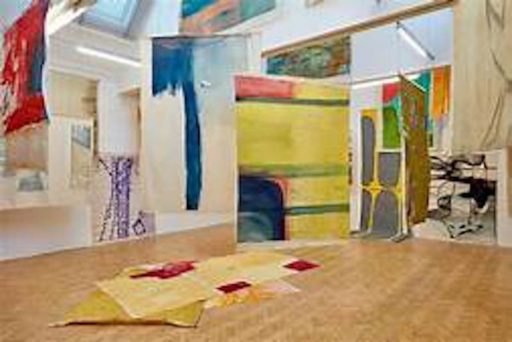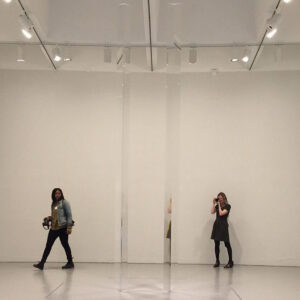There is something that especially delights me about the story, and then also the paintings, of Vivian Suter, who happens to have a show up right now at the extension of the Reina Sofia Museum in Madrid, the extension being a large building in Retiro Park called the Velazquez Palace, which is packed full right now with hundreds of paintings by Vivian Suter, more paintings than I have maybe ever seen in a one-person show and this, indeed, is part of the delight of Vivian Suter, part of what is so fascinating about Vivian Suter, namely, that she doesn’t seem to care about her canvases all that much and so you can pack a smallish palace with hundreds of them, hanging all over the place, lying in piles, whatever, some of them covered in dirt and other detritus and a couple of them marked with what seems to be the footprints of dogs, pawprints I guess.
As the story goes, Suter, born in Argentina in 1949 but then living in Switzerland as a young woman, Suter was sort of making her way as an abstract painter in the European artworld from the mid-60s to the early 80s and then she took a trip to Central America in 1982 and, basically, she never came back. She landed in Guatemala. She found a tiny village called Panajachel near a lake in the southern part of Guatemala, she got hold of an old coffee plantation there and she started painting. Did she turn her back on the world? Was she running away? Was she angry and resentful about the European artworld she was leaving behind? One can imagine many answers to these questions. Surely there was a good deal of torment. She had to have been looking for something, searching, seeking. These kinds of radical moves don’t ever come without anguish, doubt, some form of collapse. Maybe the details don’t matter all that much. Saint Anthony, hovering in the sky, tormented by a bevy of demons. We can picture it.
Vivian Suter, whatever was going on with her, whatever processes were being worked out within her, she was painting in Guatemala, painting and painting. And then another thing happened. There was a big hurricane in Guatemala in 2005, Hurricane Stan. Stan ripped right through Suter’s old coffee plantation and did a job on many of her paintings. The waters came through and the mud came through, a real deluge. Many of the paintings got splattered with mud, soaked in the deluge, bespattered with the flotsam and jetsam of the storm. It was a catastrophe. And then it happened again in 2010 with Hurricane Agatha. Another catastrophe. Another destruction of her work.
Except that Suter did something incredible. Or, actually, she did nothing. She simply accepted. She accepted the storms and the deluge and the wrecking of her paintings. And she realized that the paintings had not been wrecked at all. They had been completed. The mud and the dirt were just another form of mark on the canvas. Hadn’t so many of the great painters of the twentieth century been looking for ways to loosen the relationship between the intentionality of the artist and the finished product? Hadn’t so many artists become fascinated with chance, with letting something else in, some other force by which creations are created? And here, in Guatemala, Suter had been gifted with a mighty force indeed. How many artists can say that they have collaborated with a hurricane?
Suter, even the Suter from before the deluge, she had always been a good colorist. She understands color. And she has always had a confident hand. She makes big gestures across the canvas. Sometimes just one or two. But they feel right. A curve of color just a little this way or that. One big swoosh of green and then some waves of yellow, maybe. Red polka-dot-like circles of color here and there on the canvas. There are landscapes in some of these works. Landscapes but not too much so. The bare sense of sky and sun and water, always water. And the green foliage and sometimes the little creatures emerging here and there. Or not. Just the feel of so much growing and so much emerging and so much passing away. Or death, there it is, lurking at the edge of a darker canvas but then already being worked around into the raw material for more life.
Suter makes these canvases and then takes them off of whatever support she might have used to paint them and lets them hang around her house like draperies or drying laundry. Or she scatters them on the floor and the dog walks around on them (thus the paw prints). Or they lay out in the forest drying with whatever leaves fell upon them. As has been pointed out time and again about these works, they are not landscapes only in the representational sense, they are landscapes in the literal sense, the material sense. They actually are made, partly, of mud and leaf and animal and wind. All the forces. Whatever forces might come through on any particular day.
And these paintings, at the palace in the park in Madrid, hang in rows on long wooden racks or lie on the floor or, in a few instances, hang loosely on the wall. No fussiness. No preciousness about the absolute sanctity of The Painting as it hangs framed on the wall as do so many paintings. No, these paintings have renounced such a relationship to the world, to art. These paintings have collapsed and surrendered and given themselves over to something else entirely. And in that surrender comes a great and unexpected and mysterious gift: beauty.
Morgan Meis has a PhD in Philosophy and is a founding member of Flux Factory, an arts collective in New York. He has written for n+1, The Believer, Harper’s Magazine, The Virginia Quarterly Review and is a contributor at The New Yorker. He won the Whiting Award for non-fiction in 2013. Morgan is also an editor at 3 Quarks Daily, and a winner of a Creative Capital | Warhol Foundation Arts Writers grant. A book of Morgan’s selected essays can be found here. His new book from Slant is The Drunken Silenus. He can be reached at morganmeis@gmail.com.





